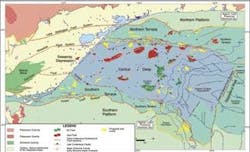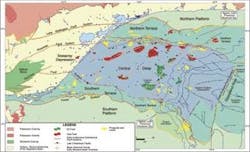Unlocking the Gippsland basin
Southeast Australia depocenter holds large potential
Offshore Gippsland basin might appear to be adequately explored over 35 years, but non-conventional opportunities abound with potential for major commercial oil and gas discoveries in the future.
One reason for such optimism is today’s technology, which is overcoming the difficulties faced by past operators while mapping important reservoirs from 2D seismic. These difficulties include velocity changes and inversions from stratigraphic variation and geologic events such as channeling and narrow valley-fills.
Dry-hole risk analysis shows that 3D seismic allows better fault-sealing studies, velocity measurement, more accurate reservoir depth estimates, and better mapping of spatial lithologic variation.
As of year-end 2004, about 45 fields have been discovered in the basin; some of the fields are waiting appraisal and production. Around 20 oil companies are engaged in the E&P business within this basin. Recent discoveries are smaller in size ranging from 60-150 MMboe.
Smaller discoveries should not be a cause for alarm or keep away new explorers because this basin provides one of most extensive infrastructures. Future discoveries of smaller fields can also be put into quick production mode by economically tie-in with such existing facilities.
The Gippsland basin, may not be so well-known in the Western Hemisphere’s oil industry, but it provides significant energy security to Australia. Oil and gas’ economic impact on Australia from the Gippsland basin is colossal and strategically balances market forces from other oil-producing nations to benefit global consumers. The Pacific Rim economies also benefit from the prolific oil production from this basin.
Gippsland basin, a well-defined rift system of Mesozoic-Cenozoic age, was born from the break-up of the super-continent, Gondowanaland, and the separation of the Australian continent from the Antarctic continent during Late Jurassic to Early Cretaceous, a period of intra-continental rift. The basin occupies both land and marine areas of 41,000 sq km, and the sediment thickness reaches over 7.5 km.
The first big oil discovery in Australia is credited to the onshore Gippsland basin in 1924, when a water well drilled in Victoria encountered about 50 ft of oil column at a depth of 1,025 ft. This led to further drilling.
null
In later years, several dozen wells were drilled to produce 15.7° API heavy biodegraded oil. Only about 8,000 bbl of viscous oil was produced from this onshore site. This, however, provided proof of potentially major commercial hydrocarbon reserves within the offshore portion of the basin between Tasmania and Victoria State.
Another 20 years or so passed after World War II before American consultant and geologist Lewis Weeks suggested a seismic survey over the offshore Gippsland basin. His ideas led to first common depth point seismic reflection data in 1964, and in the same year Esso drilled a discovery well on a lease farmed-out by BHP. The Barracouta-1 well, drilled on a four-way closure structure, found major gas reserves. This encouragement provided incentives for continued exploration drilling, and in 1967 Australia’s largest oil field Kingfish was discovered. This field is estimated to hold 1.2 Bbbl of recoverable oil. Further drilling led to the discovery of another giant oil field - Halibut.
From 1962-69 operators discovered 11 fields, and out of 22 wildcat wells 13 were commercial discoveries. This is the “top secret” of the offshore Gippsland basin - a very high success rate.
Although global investment created various episodes of exploration and production in the basin, it continues to surprise operators with excellent commercial discoveries of oil and gas. So far, the basin has provided over 4 Bbbl and 10 tcf of gas as proven reserves. The cumulative production as of 2001 is 3.44 Bbbl and 4.8 tcf of gas. Additional exploration, currently underway, will provide more reserves in the coming years.
A dry-hole risk analysis of the basin produces some interesting observations that new explorers need to keep in mind. It is important to give special attention to seismic acquisition, processing, velocity determination, seal mapping, reservoir mapping, and fault-seal mapping during exploration in this major rift basin.
The source rocks for the basin are a combination of terrestrial (coals), lacustrine (shale), and marginal marine (shale). These rich source rocks generated huge hydrocarbon volumes that are trapped within the Golden Beach sands and in the fluvio-deltaic and slope-fan sands of the Upper Latrobe. These reservoirs are sealed by marine shale, lacustrine shale, and carbonates (Lakes Entrance formation).
Hydrocarbon generation and migration activities occurred in two stages and in two geologic times atypical of rift-and-sag basins. The first significant generation began in Paleocene when the thick Latrobe Group was being rapidly deposited. This generation and migration phase ended during Eocene. A second phase began in the Miocene with the deposition of the Seaspray Group carbonates and related subsidence.
This basin has provided the bulk of Australia’s crude production of over many years. Production trends in the basin indicate high-performing Tertiary reservoirs. The oil production began a decline several years ago with the shortfall being filled by large gas-condensate discoveries. The production/consumption ratio is sustainable for another 20 years or so.
Australia’s crude oil production averages slightly over 650,000 b/d and the gas production ranges 3-3.5 bcf/d. The remaining reserve estimate for the Gippsland basin, beginning as of 2002, stands at about 770 MMbbl (including condensate). The gas reserve is about 6 tcf.
Business environment
The non-discriminatory policies of governments at both provincial and commonwealth levels provide an equal playing field to local and foreign oil companies, as well as to independents and majors. Such an open door policy, combined with excellent terms, has encouraged significant investment from the global E&P community. The most attractive elements of dealing with government officials in Australia are:
• Single-window and rapid response from friendly officials
•People in the decision process speak the explorer’s technical language
•Open-book non-restrictive data review opportunity
•Pro-business attitude and great investment terms.
New seismic acquisition and processing technologies provide clues to a better understanding of reservoir geometry, fault-sealing styles, un-conventional plays, and future giant discoveries. Continuous expansion of gas markets for power-generation has triggered rapid development of gas discoveries.
Australia’s “old lady,” the offshore Gippsland basin, still sings by providing commercial discoveries (2003-04) and remains a great target for future exploration.




